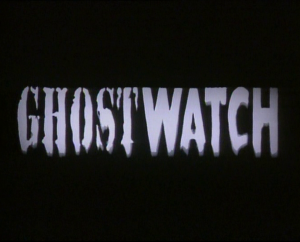 “On Saturday night we’ll be visiting the most haunted house in Britain, but will the ghosts be there? Can you take it?”
“On Saturday night we’ll be visiting the most haunted house in Britain, but will the ghosts be there? Can you take it?”
That was the wording to the trailer for Ghostwatch, a 90 minute drama which was shown once, and only once, on BBC1, on Halloween 1992. I was 14 years old when I saw that trailer, and decided to watch the programme, thinking this was a real documentary, which was the impression the trailer gave. It was in fact a scripted drama production, one of the first examples of a “found footage” supernatural horror ever made, predating The Blair Witch Project and Paranormal Activity. The BBC bottled on the idea, and insisted on including a writer’s credit for Stephen Volk, and showing the programme as part of their “Screen One” drama strand. Despite that, many viewers, myself included, started watching the show with the assumption that what we were seeing was real. So how exactly did that happen? Let’s look at the evidence.
 Firstly, we had the listing in the RadioTimes, which described the programme as a…
Firstly, we had the listing in the RadioTimes, which described the programme as a…
“Screen One special drama for Hallowe’en by Stephen Volk, starring Michael Parkinson, Sarah Greene, Mike Smith, Craig Charles. Ghosts no longer inhabit stately homes and rattle chains. They live in ordinary council houses like that of Mrs Pamela Early. For months she’s suffered strange noises, awful smells and bent cutlery, but is hers really the most haunted house in Britain? BBCtv turns the cameras on ghoulies, ghosties and things that go bump in the night.”
If you had read that at the time, and were paying attention, the words “drama” and “by” should be enough to alert you to the true nature of the show. The rest of it could apply equally to a real documentary. Then we had the pre-show continuity announcement:
“Now on BBC1 Screen One presents an unusual and sometimes disturbing film marking Halloween. Over the centuries there have been countless reports of ghosts and ghouls, but the line between fact and fiction has always been unclear. Using the modern idiom of the outside broadcast, Michael Parkinson, Sarah Greene, Mike Smith and Craig Charles star in Ghostwatch.”
Again, there are words there to indicate what we were about to watch wasn’t real: “film”, and “idiom”. There were clearly a few problems with this though. To know that this was a drama you had to (a) be a buyer of RadioTimes and be paying attention to the listing and/or (b) be paying attention to that continuity announcement. If, like me, you had seen the trailer and neither (a) nor (b) applied to you, then you were going into this thinking it was a documentary. I’m not blaming the BBC for that, but it’s perhaps an important lesson for programme makers. Not everyone watches right from the opening credits. More importantly, not everyone watches right to the end, and in the case of Ghostwatch that was perhaps a much bigger problem. We’ll get to that.
If you’ve read this far, you might be wondering what all the fuss is about. Well, Ghostwatch resulted in tens of thousands of calls to the BBC switchboard and was connected (arguably) with a tragic suicide of a viewer. A medical report described post-traumatic stress disorder in some children who had watched the show. Sarah Greene, one of the presenters, had to appear on Children’s BBC the following Monday to reassure children that none of it was real. After Match of the Day, which followed Ghostwatch, the continuity announcer read out the following message:
“If you were with us for our Ghostwatch earlier, may I reassure you that it was just a story and all’s well here at Television Centre.”
By then it was after midnight, and the cat was well and truly out of the bag (well, out of the glory hole). There has been many a word typed about Ghostwatch over the years, but it is one of my favourite television programmes ever made, so this is going to be a long one. Strap yourselves in, for one of the most detailed looks at Ghostwatch ever written…
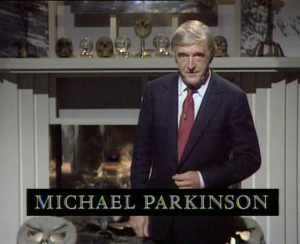 The opening credits carry the caption “Michael Parkinson in Ghostwatch by Stephen Volk”, clearly indicating for those who were paying attention that this is a work of fiction… I suppose. Arguably, the caption would sort of make sense if Volk was somebody who had come up with the concept for the programme and Parkinson was just the presenter. In truth, Volk (now 66 years old) was a writer specialising in supernatural dramas, and went on to write several supernatural films and novellas, often fictionalising real people as characters, blurring the lines between fiction and reality as he does here. Parkinson (now 85), on the other hand, was not a name anyone would have expected to be associated with drama. He was a respected talk show host, probably the most respected talk show host Britain has ever produced. The original run of his interview series had ended in 1982, but would be revived in 1998 and run through to 2007.
The opening credits carry the caption “Michael Parkinson in Ghostwatch by Stephen Volk”, clearly indicating for those who were paying attention that this is a work of fiction… I suppose. Arguably, the caption would sort of make sense if Volk was somebody who had come up with the concept for the programme and Parkinson was just the presenter. In truth, Volk (now 66 years old) was a writer specialising in supernatural dramas, and went on to write several supernatural films and novellas, often fictionalising real people as characters, blurring the lines between fiction and reality as he does here. Parkinson (now 85), on the other hand, was not a name anyone would have expected to be associated with drama. He was a respected talk show host, probably the most respected talk show host Britain has ever produced. The original run of his interview series had ended in 1982, but would be revived in 1998 and run through to 2007.
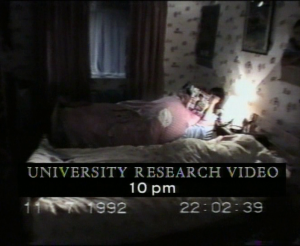 Before even one minute has elapsed, we get our first example of “found footage”, the “University Research Video” footage of the Early girls, complete with time clock. It’s standard poltergeist stuff, with banging noises and things being thrown around, culminating in a light exploding. Suzanne and Kim Early were played by Michelle and Cherise Wesson, sisters in real life. Michelle has a handful of acting credits to her name, the last in 1998. Ghostwatch seems to have been Cherise’s only television appearance. The internet comes up blank on the question of what happened to the two girls, and they are not included in the straight-to-DVD Ghostwatch: Behind the Curtains documentary. According to director Rich Lawden on his excellent blog, “Despite repeated attempts, I’ve never successfully been able to get a message through to Bríd, Michelle or Cherise, though would love if it could happen, someday”. Presumably Cherise must now be in her late 30s, and Michelle perhaps in her early 40s. Time flies.
Before even one minute has elapsed, we get our first example of “found footage”, the “University Research Video” footage of the Early girls, complete with time clock. It’s standard poltergeist stuff, with banging noises and things being thrown around, culminating in a light exploding. Suzanne and Kim Early were played by Michelle and Cherise Wesson, sisters in real life. Michelle has a handful of acting credits to her name, the last in 1998. Ghostwatch seems to have been Cherise’s only television appearance. The internet comes up blank on the question of what happened to the two girls, and they are not included in the straight-to-DVD Ghostwatch: Behind the Curtains documentary. According to director Rich Lawden on his excellent blog, “Despite repeated attempts, I’ve never successfully been able to get a message through to Bríd, Michelle or Cherise, though would love if it could happen, someday”. Presumably Cherise must now be in her late 30s, and Michelle perhaps in her early 40s. Time flies.
“So welcome live this Halloween night…”
For those who mistakenly believed this to be real, the pretence is established strongly at the start, with the show actually broadcast 31st October. Whenever time clocks appear throughout the show, they always display the correct date and time of broadcast, as if the show were live. Parkinson describes it as “an unprecedented scientific experiment”. This was long before ghost hunting shows were commonplace on television. The most famous in Britain, the tedious Most Haunted, didn’t begin for another decade, so we weren’t used to the boredom of ghost hunting shows where little ever happens. This was something very new and seemed like a genuinely scary idea at the time.
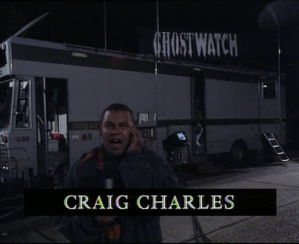 Before the four minute mark we are introduced to Craig Charles, presenting the outside broadcast, joking around in his usual Craig Charles manner. Craig was already an established presenter and actor, and had been filming in Red Dwarf since 1988. Now 56 years old, Craig has gone on to a long-running stint as a BBC Radio Two presenter, ten years in Coronation Street, huge success with Robot Wars and as the UK voice of Takeshi’s Castle, and of course lots more Red Dwarf. Next we are introduced to Mike Smith, who is manning the phone lines. The number given was a standard BBC number at the time, and callers heard a recorded message telling them that the show was fictional. A good idea… except the lines were jammed with callers, and lots of people got an engaged tone instead. Considering the nature of the last half hour of the show, the engaged tone inadvertently added to the impression that… well, we’ll get there.
Before the four minute mark we are introduced to Craig Charles, presenting the outside broadcast, joking around in his usual Craig Charles manner. Craig was already an established presenter and actor, and had been filming in Red Dwarf since 1988. Now 56 years old, Craig has gone on to a long-running stint as a BBC Radio Two presenter, ten years in Coronation Street, huge success with Robot Wars and as the UK voice of Takeshi’s Castle, and of course lots more Red Dwarf. Next we are introduced to Mike Smith, who is manning the phone lines. The number given was a standard BBC number at the time, and callers heard a recorded message telling them that the show was fictional. A good idea… except the lines were jammed with callers, and lots of people got an engaged tone instead. Considering the nature of the last half hour of the show, the engaged tone inadvertently added to the impression that… well, we’ll get there.  Smith was an established presenter, married to Sarah Greene, who we will get to in due course. Smith tragically died in 2014, at the far-too-young age of 59.
Smith was an established presenter, married to Sarah Greene, who we will get to in due course. Smith tragically died in 2014, at the far-too-young age of 59.
Just after the five minute mark Craig Charles interviews the Early family, and here for the first time anyone thinking this is a documentary might start to have their doubts, because some acting is needed for the first time. Up to this point we have really just had presenters being presenters, but now we have kids trying to act. But it’s not necessarily a complete giveaway, because an equally reasonable assumption would be that the interview has been rehearsed. That is relatively commonplace, at least to the extent of discussing with interviewees what kind of questions will be asked. So viewers expecting a documentary might be thinking at this point that these kids have maybe been heavily prompted in advance by their mother and/or the producers, rather than smelling a rat. Playing the girls’ mother Pam is Brid Brennan, now 65 years old and best known for her theatre work, although she has had a prolific television acting career. She is great throughout Ghostwatch at playing a mother who is desperately trying to hold it together, and protect her daughters from the criticisms and assumptions of outsiders, while living in terror.
T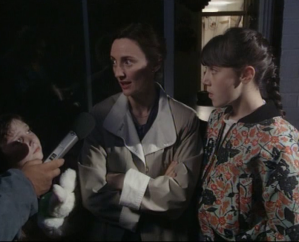 his interview with the Early’s has been suggested as containing our first sighting, but there’s almost certainly nothing to be seen here. What is clear is that the director intended it do be a sighting and has confirmed that. It’s also reasonably clear that the actor playing Pipes was behind the glass when this was shot, as confirmed by the production schedule. There is also a sighting here written into the script. If there’s anything at all to be seen, it’s the merest hint of a shadow, virtually impossible to distinguish from the shadows of Craig and the Early family on the glass. I’ve replayed the shot many times and despite the intentions of the programme makers I think it’s fair to conclude that they dropped the ball on this one, and it’s not really reasonable to include a vague shadow which might or might not just be the reflection of somebody’s head, as a sighting.
his interview with the Early’s has been suggested as containing our first sighting, but there’s almost certainly nothing to be seen here. What is clear is that the director intended it do be a sighting and has confirmed that. It’s also reasonably clear that the actor playing Pipes was behind the glass when this was shot, as confirmed by the production schedule. There is also a sighting here written into the script. If there’s anything at all to be seen, it’s the merest hint of a shadow, virtually impossible to distinguish from the shadows of Craig and the Early family on the glass. I’ve replayed the shot many times and despite the intentions of the programme makers I think it’s fair to conclude that they dropped the ball on this one, and it’s not really reasonable to include a vague shadow which might or might not just be the reflection of somebody’s head, as a sighting.
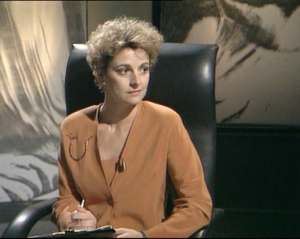 At the six minute mark we are introduced to Dr Lin Pascoe, our expert in the paranormal who already knows the Early family and has been working with them to investigate their case. She will be in the studio for the whole programme, discussing the case and reacting to events.
At the six minute mark we are introduced to Dr Lin Pascoe, our expert in the paranormal who already knows the Early family and has been working with them to investigate their case. She will be in the studio for the whole programme, discussing the case and reacting to events.
“The first thing you can do is believe them.”
Dr Pascoe is played by Gillian Bevan, who is now 64 years old. Like Brid Brannan she is also known chiefly for her theatre work, but has appeared in a variety of television shows over the years.
My memory is hazy of my first experience of Ghostwatch, but I do remember believing it was real, but not watching very much of it at all. The reason for that, I think, is the following line from Michael Parkinson:
“For those night owls amongst you, we will be here with updates roughly every hour right through the night.”
At that point I reached the conclusion that if anything happened it would be very late into the evening, probably not until midnight at least, and I wasn’t quite at the age where I was going to stay awake all night for a television show. I can’t say for sure the exact point at which I switched off, but I do know that forming the impression that this show was going to run all night was the main factor in that decision. My first complete viewing of Ghostwatch was therefore the original BFI DVD release from 1992.
The pretence of a show that’s going to run all night adds to the impact of what happens at the end of the film. If you were a viewer who thought this was real, that information conflicts with the RadioTimes listing, which shows a finish time of 11pm for the start of Match of the Day, but that in itself probably wouldn’t have been enough to sway many viewers into thinking they weren’t watching a live show, as the magazine listings were prepared well in advance and it was not uncommon for them to change after the magazine was printed.
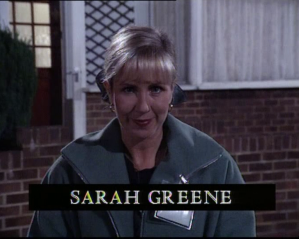 Just before the seven minute mark we have our first chat with Sarah Greene, who is supposed to be spending the night in the haunted house. Reportedly (and mainly anecdotally) a lot of children stayed up to watch Ghostwatch. This being Halloween, a lot of children would be staying up late anyway. Although this was a post-watershed show, the presence of Greene and Smith would have added an air of comfort and safety to the proceedings. Greene was known for her work as a children’s television presenter, in programmes such as Blue Peter, Saturday Superstore and Going Live! Now 62 years old, Sarah has done only occasional presenting work in recent years.
Just before the seven minute mark we have our first chat with Sarah Greene, who is supposed to be spending the night in the haunted house. Reportedly (and mainly anecdotally) a lot of children stayed up to watch Ghostwatch. This being Halloween, a lot of children would be staying up late anyway. Although this was a post-watershed show, the presence of Greene and Smith would have added an air of comfort and safety to the proceedings. Greene was known for her work as a children’s television presenter, in programmes such as Blue Peter, Saturday Superstore and Going Live! Now 62 years old, Sarah has done only occasional presenting work in recent years.
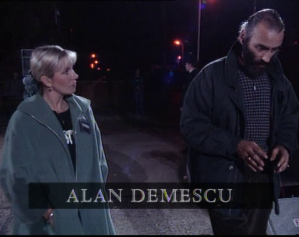 Over the next few minutes this is Sarah’s show, as she introduces us to her team on location and the equipment they will be working with. Alan Demescu (played by Mark Lewis) is a paranormal researcher who explains some of the tech. We have a chat with cameraman Chris Miller (that’s his real name) and then see Sarah on the infra-red camera, something that won’t feature until very late in the game. Ten minutes into the show we are introduced to Mike Aiton (also his real name) the sound recordist. He is a bit awkward being interviewed and looks a bit embarrassed, which makes perfect sense and doesn’t destroy the illusion, because he’s probably not used to being on the wrong side of the camera. And then, at just past the eleven minute mark, Sarah goes into the house for the first time. It’s a picture of normality, with the family doing apple bobbing and the house decorated for Halloween, although one wonders why this family would want to have anything to do with Halloween traditions. It perhaps makes more sense within the fiction of Ghostwatch if we assume the producers would have set that all up.
Over the next few minutes this is Sarah’s show, as she introduces us to her team on location and the equipment they will be working with. Alan Demescu (played by Mark Lewis) is a paranormal researcher who explains some of the tech. We have a chat with cameraman Chris Miller (that’s his real name) and then see Sarah on the infra-red camera, something that won’t feature until very late in the game. Ten minutes into the show we are introduced to Mike Aiton (also his real name) the sound recordist. He is a bit awkward being interviewed and looks a bit embarrassed, which makes perfect sense and doesn’t destroy the illusion, because he’s probably not used to being on the wrong side of the camera. And then, at just past the eleven minute mark, Sarah goes into the house for the first time. It’s a picture of normality, with the family doing apple bobbing and the house decorated for Halloween, although one wonders why this family would want to have anything to do with Halloween traditions. It perhaps makes more sense within the fiction of Ghostwatch if we assume the producers would have set that all up.
At the 13 minute mark we have our first call into the studio, and this is a key moment, building up to the first sighting of “Pipes” the ghost. On the line is Emma Stableford from Slough, who wants to talk about the footage of the girls we saw at the start of the show.
“I was sure I could see a figure standing behind, against the curtain.”
Of course, there was no such thing when we saw the footage, but we’ll get to that in good time. The caller unfortunately sounds like she is reading out a speech, but again this wouldn’t necessarily indicate to the viewers that they aren’t watching something real. It’s not unusual for a caller to a television or radio show to make notes about what they want to say, and calls can sound scripted. In fact, I remember a DJ on a radio show going off on a big rant with a caller for phoning his show and reading out a prepared speech instead of actually having a conversation. It happens.
We then have Craig playing a practical joke on Sarah, and some friendly banter about Mike having a bet with Craig about trying to get Sarah to swear. Lin looks annoyed in the studio. Then it’s time for Pam to get the kids to bed. It’s all a bit of a slow start to proceedings, and at this stage it’s looking like this show is really turning out to be a prototype for Most Haunted, with a lot of talking a not much happening. I suspect it is around this point I switched off, on first viewing.
At 19 minutes we get to see Kim’s drawing of Pipes, preparing us for an actual sighting, and then we see the nasty scribbled writing in Suzanne’s book, which might just put a seed of doubt into the mind of the viewer. Could this be a couple of disturbed children, faking a ghost for attention? Anything is possible at this stage of the game. And then it’s time to pick up on that caller’s comment about the recording we saw earlier, and at last we have…
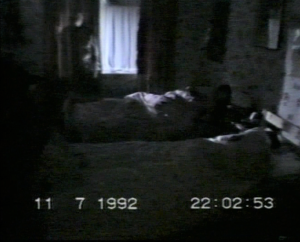 Sighting #1
Sighting #1
Here we go: a key moment in Ghostwatch. We see the same footage we saw earlier, but with a difference. At 21 minutes, to the second, we are watching the “found footage” again, the lights go off in the girls’ bedroom and Pipes is standing by the window. Long before the days of pausing a rewinding live television, nobody watching could go back and check (and if you were taping the show you weren’t going to stop the tape), but Pipes is definitely not there in the original version of this footage. At 21.30 it’s played again and he’s not there, and at 22.00 we get a fourth screening of the tape and he’s back again. This is our first indication that the ghost is messing with the equipment somehow, and it’s incredibly creepy. Lin is sceptical and doesn’t seem to be able to see what we are seeing, which is a wonderful touch of dramatic irony, and also will perhaps start to give the viewer a feeling of unease that not everyone is seeing the same thing here. It’s also worth noting that Lin doesn’t immediately jump to the conclusion she obviously wants from this, that the ghost is there, and her scepticism adds to her credibility as an expert.
At 24 minutes Pam breaks down in tears again when she’s describing her encounter with Pipes in the glory hole under the stairs, and we learn that the council refused to move the family. They didn’t take it seriously and a social worker told Pam that they need to see a psychiatrist. We then see footage from a television interview, and some newspaper reports, again adding credibility to the sense that this is a documentary. At 27 minutes Sandra Hughes from Sussex calls, with an anecdote about her own experience of ghost activity and her discovery about a boy who had died, seeding that idea for the first time.
When we get to see some more of the research footage at 28.30, fans of Stranger Things will be familiar with the technique being used: the deprivation of sensory inputs. At 30 minutes Suzanne speaks with the voice of Pipes, played on a ReVox A77 Mk III reel-to-real tape player. The voice of Pipes was provided by director Lesley Manning. It’s very difficult to hear what Pipes is saying, but standing out amongst the guttural growls are the words of a nursery rhyme:
“Round and round the garden, like a teddy bear…”
If you want to know everything said by Pipes, take a look at the following subtitled YouTube clip, but be warned that it’s not pleasant:
After some discussion about Suzanne being the focus of the activity, everyone get ready to boo, because it’s time to meet American sceptic Emilio Sylvestri. He says “it could all be done with wires as far as we know”, and talks about “loony theories”. Lyn makes a great point when she accuses him of having his own belief system, “blanket denial”, and Sylvestri’s response is to resort to insults:
“You ought to be selling crystals…”
 Sylvestri is more of a caricature than any other character in Ghostwatch, and writer Stephen Volk presumably has little time for “experts” of this nature, or at least that’s what comes across in his writing. In Volk’s sequel story 31/10, Sylvestri is among the characters who return to the set of Ghostwatch for the tenth anniversary of the show, and Volk paints him as a man who has cashed in on the show and has a “past record of cheap jibes and castigations against the production team”. In the story, Ghostwatch is treated as a real documentary, and Alan Demescu asks him what he believes really happened:
Sylvestri is more of a caricature than any other character in Ghostwatch, and writer Stephen Volk presumably has little time for “experts” of this nature, or at least that’s what comes across in his writing. In Volk’s sequel story 31/10, Sylvestri is among the characters who return to the set of Ghostwatch for the tenth anniversary of the show, and Volk paints him as a man who has cashed in on the show and has a “past record of cheap jibes and castigations against the production team”. In the story, Ghostwatch is treated as a real documentary, and Alan Demescu asks him what he believes really happened:
“Only that people experienced some delusion on a grand scale. On a scale of eleven million viewers, to be precise. But just because David Copperfield makes the Statue of Liberty disappear on ABC doesn’t mean it isn’t still there when you look the next morning.”
But with Sylvestri actually present in the studio himself this time, Volk takes a joy in giving the character his comeuppance…
Following on from Lyn’s debate with Sylvestri, we get to hear Sarah Greene’s own ghost story (added in by Sarah, not in the original script, and true), and it’s a very traditional one, involving the need to resolve something for the ghost. Is there something in the past of Pam’s house that needs to be resolved as well?
Look carefully in the background of the shot at around the 42 minute mark. Sarah is broadcasting from the kitchen, in on the stairs behind her it’s possible to spot Kim hiding there. What is she up to? We learn that the sound man’s watch has stopped, which is a regular occurrence in the house according to Lyn, and then it’s time for an anecdote from another victim of a haunting. It’s unintentionally amusing: “saliva all over the mackerel… of course we couldn’t eat it.” You don’t say. But this fits in with what would be a natural awkwardness of a member of the public being interviewed.
We are building up to another key moment, with Craig interviewing a few people outside. He speaks to Arthur Lacey, the unsuccessful exorcist, and just as he is introducing us to him, we have…
 Sighting #2
Sighting #2
This one is easy to miss. At 47.25 keep an eye on the crowd of extras. Standing right behind the exorcist is Pipes! He obviously didn’t like Lacey much.
“Something didn’t want me near it – didn’t believe it was dead.”
The sighting is kept subtle and obscured in darkness, and it makes you wonder if a Blu-ray release would reveal one or two extra sightings in some of the very dark moments in the episode, at a higher resolution than the DVD. Rumour has it that there are still more appearances of Pipes waiting to be found. Here’s what director Lesley Manning had to say about that in the 20th Anniversary documentary Ghostwatch: Behind the Curtains:
“I think it’s documented that there are eight sightings. I believe that we put more in. In my head, I have the figure, thirteen, but I won’t stand by it.”
Craig’s outside broadcast is interrupted, adding to the illusion of live television, because damp circles have appeared in the house. At 51 minutes Sarah goes to get some water and the tap is very erratic and accompanied by a bit of banging. This is a clever red herring, because dodgy plumbing could at least be an explanation for the noises attributed to Pipes in the house. After a call from viewer Kevin Tripp from Neath, whose plate of sandwiches leapt onto the floor (Parkinson: “It’s Halloween night, home brew time.”), we are back to the house where Sarah is trying to track down the source of a scratching noise. This is the start of our first major activity in the house. The kids say Pipes is downstairs and at that moment the banging starts and the camera goes odd. Downstairs there are drawings scattered everywhere and then we have…
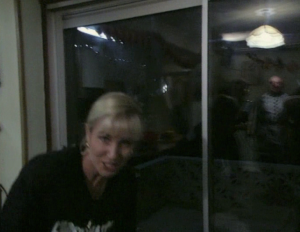 Sighting #3
Sighting #3
At 55 minutes Pipes is visible on the patio outside, or is it instead his reflection in the patio doors and he’s inside the kitchen? It’s hard to tell. Michael tells Sarah to stay where she is, because Suzanne is missing from the static cameras. Somebody has obviously smelt a rat, and when she is located by panning down a camera, we have a shock revelation and the biggest red herring of the whole programme: Suzanne is creating the banging noise.
“Oh dear.”
This is such a clever bit of writing, because it lulls the viewer into a false sense of security, even if just for a moment. We are faced with a disappointing, rational explanation for the activity, and everyone in the studio seems a bit shell shocked.
“The children feel obliged to come up with the goods.”
… and yet the nagging feeling of unease doesn’t quite go away, and most viewers will have probably caught a glimpse of Pipes on at least one of the three occasions he has appeared, even though the sightings have been relatively subtle, so what is going on here? Michael’s questioning of Suzanne comes across as a bit harsh, and I suspect in a real life situation the producers would have stepped in at this point and the children would not have featured in the programme from that point onwards, but it brings us to our explanation:
“All we were was noises to you… We just gave you what you wanted.”
Pam looks shaky and Sarah just looks really sad. These are great performances. They really sell the moment. And of course it’s time for Sylvestri to put the boot in:
“These are disturbed attention seekers.”
All together now… booooo! If this is the calm, the storm is about to hit. At the one hour mark people are phoning in and describing Pipes. At 61 minutes Laura’s ghost story is on the screen and the tape goes funny and stops. Things are starting to go wrong in the studio now. At 63 minutes viewers are starting to report activity in their own homes: a glass table exploding (this is based on a true story), clocks stopped, frightened children who won’t be dragged away from the television (that last one was perhaps reflected in real life), and Michael steps in to try to calm down the general public, with hysteria spreading across the nation. Unknown to the makers of Ghostwatch, this is art imitating reality to a certain extent.
“We don’t want to start panic.”
But let’s pause for a minute and think about the question of what the makers of Ghostwatch were actually trying to do here? Was the original plan to deceive the public, before the ameliorating factors of the writer’s credit, etc, were introduced? In the 20th anniversary documentary, Ghostwatch: Behind the Curtains, there is some talk of War of the Worlds as a source of inspiration. As the plot of Ghostwatch bears no relation to a story about aliens invading, it’s fair to assume this refers to the panic generated by the 1938 radio adaptation. I don’t think anyone was genuinely trying to cause panic amongst the British viewing public, but it’s hard to get a handle on what exactly the intention was at the planning stage, if not to deceive. Writer Stephen Volk shed a little light on that in the documentary:
“I thought people would start watching it, and within five minutes they see Parkinson, they may or may not think it’s real when they’re watching the first five or ten minutes, and then they kind of go Oh, I see. This is what they’re doing. And they’d kind of stay with it and enjoy it for the kind of conceit of it. That’s honestly what I thought would happen.”
At 64 minutes we learn that Kim’s description tallies with the viewers’ sightings of Pipes, and a couple of minutes later we get the sound of trapped cats in the house, followed by the shocking sight of Suzanne’s scratched up face. This is perhaps the most disturbing moment in the film. It’s not necessarily the most frightening, but the sight of a teenage girl with her face covered in scratches must certainly have been a very unusual sight on British television at the time. Both possible explanations are deeply unpleasant: self harm, or a physical attack from an abusive ghost, but the self harm explanation is swiftly dismissed:
“Fingernails? What flaming fingernails?”
When Sarah goes to get a flannel for Suzanne listen carefully, because we can hear a breath just before Sarah says she saw something behind the door. At 70 minutes we learn the story of Mother Seddon, a child killer who used to live in the house. Could Pipes be a female apparition? Appearances suggest otherwise, but Kim says that he or she looks “like somebody’s mum”. Could there be two apparitions present in the house? Everybody at this point is wisely trying to get the children out of the house, but they refuse to go. Everything is kicking off now, and at 71 minutes we have…
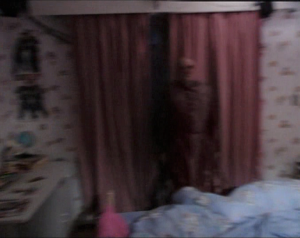 Sighting #4
Sighting #4
To the sound of banging, the camera pans around the bedroom and we get a clear shot of Pipes stood there, but when the camera hastily pans back he’s gone. Creepy. Meanwhile, back in the studio the phone lines are going crazy, with art once again imitating reality. People are reporting stopped clocks, radios gone dead, microwaves pinging, dogs barking and glasses breaking. In the Ghostwatch: Behind the Curtains documentary, Lesley Manning explains what was going on with the real phone lines on the evening:
“We took it all very seriously, because we assumed that if there was a phone line on the thing, somebody would phone up, so we had two. There were the BBC phone lines that were always there, and there was a separate bank manned by parapsychologists.”
Of course, the phone lines were quickly overwhelmed, and contemporary viewer Jo Sharples recounts in the documentary her attempts to get through:
“The amount of times we rang that number, I tell you! We were like, no! And there was the bit where they had somebody call in, and say oh, there’s the shadow in the curtains. And they drew around and we were going, no, you’ve missed the head! No! Ring the number, ring the number again!”
So how many people tried to phone? Estimates vary wildly, but at the higher end of the scale we have producer Ruth Baumgarten’s interview in issue 59 of Samhain Magazine:
“I had a breakdown from British Telecom, and during the peak five minutes it was over a hundred thousand. So assuming that they started ringing in after twenty minutes it must have been, I think, over a million altogether.”
If that’s the case, it shows the scale of the impact of the programme, and the extent to which people were believing what they were seeing, with perhaps around 10 percent of the viewers motivated to pick up the phone.
At 73 minutes the picture and sound are breaking up, and at 74 minutes there is poltergeist activity, with a picture being thrown. Then Suzanne seems to have been possessed by Pipes (“what big eyes you have”) and Sarah finds that Kim has drowned her cuddly bunny, just like Mother Seddon used to do with children. Pipes told her to do it. At 76 minutes the cat sounds are clearly coming from the glory hole, and then at 77 minutes we have…
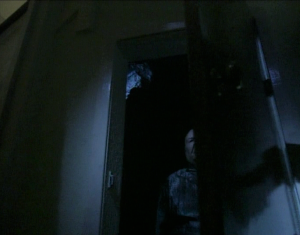 Sighting #5
Sighting #5
This is a really creepy one, with the door to the glory hole slowly opening to reveal Pipes clearly stood there. The activity is getting more and more violent, with the sound man injured and Suzanne complaining that Pipes is “touching me. He’s hurting me.” Nasty stuff. And then…
“Normal Transmission will resume as soon as possible.”
This next part is great, because it’s such a realistic portrayal of the confusion and chaos when a live broadcast goes wrong. We cut to the only place where there is still some normality: Craig on the outside broadcast, still being all jolly, but the sound is a mess with Michael talking over the top of him. Then Craig thinks he is no longer on camera but the editor has failed to cut away from him elsewhere.
“I wish someone would have said we were on then… only at the BBC, lads.”
At 78 minutes the link with the house is restored and everything looks oddly “back to normal”. At this point astute viewers will have been shouting at the screen that this is footage from earlier in the evening, rather than live. Back in the studio, poor Mike is looking absolutely… well, haunted.
“I was ready to… I don’t know.”
His worry and frustration is palpable. His wife is in danger and she’s too far away for him to help her. At 79 minutes a caller fills us in on the rest of the back story for the house, which explains the sounds of the cats and the significance of the glory hole. Apparently a former resident of the house was possessed by Seddon and continued her crimes. So what is Pipes? Some kind of a combination of the two criminals who lived in the house? It seems to somehow embody both of them.
At 82 minutes the penny drops. Lyn realises “it’s in the machine”, and the “picture we’re seeing now isn’t live”. Almost as if it’s responding to her words, the ghost allows us to see what is actually happening in the house, while the activity in the studio intensifies. This brings us to the moment where the production arguably went too far:
“We’ve created a seance. A massive seance.”
This involves the viewer in the drama in a way that was clearly terrifying for some people at the time. It’s also worth acknowledging that this is an idea that is way ahead of its time, and a particularly sinister lean on the fourth wall. Films such as The Ring have since suggested that watching something can curse the viewer, but Ghostwatch takes a step even further than that, extending the curse even to the audience of the television show. Anyone watching who still thought this was real must have been feeling nervous at this stage to say the least. But according to Volk in the documentary, “television isn’t just about piping safe things into people’s homes to make them feel warm and comfortable. It’s also about challenging their preconceptions, and about shaking them up, a little bit.” He goes on to (slightly mis)quote horror novelist Ramsey Campbell: “Sometimes, horror is about the business of going too far.”
Back with Craig and the outside broadcast unit, the street looks like the aftermath of a disaster, with paramedics and police now in attendance.
“We’ve seen Mike come out. We’ve seen Kim. We’ve seen Pam. That leaves Suzanne and Sarah.”
In his short story 31/10, Volk claims the whereabouts of these two were never discovered, and cheekily even suggests that Sarah Greene’s subsequent television appearances were done by a double! With five minutes to go, we’re back in the house and the camera has switched to night filming, with all the lights out. The infrared filming is one of several cutting edge techniques used in Ghostwatch, along with the wall of screens in the studio and the pixelation of one of the vox pops. These are thing we take for granted now, but were at the forefront of technology at the time.
Sarah is really shown to be a hero here, as she is determined to find Suzanne and won’t leave until she has. She never puts her own safety first. Her final act of bravery is of course to go into the glory hole after Suzanne, while lights smash in the studio. Which brings us to…
 Sightings #6 and #7
Sightings #6 and #7
These are our final two sightings, only a second apart from each other. The first is hard to spot, and I suspect most viewers wouldn’t have noticed it. It’s a close-up, distorted shot of Pipes, and you really have to pause the shot to get anything other than a fleeting, almost subliminal moment. The final sighting leaves us in no doubt that Pipes has moved beyond the boundaries of the house, because he’s visible up on the gantry in the studio.
“Clear the studio! Get out!”
 Brave Mike refuses to leave, until he knows his wife is safe, and then we have our final, chilling moments, with Michael wandering around the darkened studio in a state of confusion, until finally he sees “round and round the garden” on the autocue, and is himself possessed by Pipes.
Brave Mike refuses to leave, until he knows his wife is safe, and then we have our final, chilling moments, with Michael wandering around the darkened studio in a state of confusion, until finally he sees “round and round the garden” on the autocue, and is himself possessed by Pipes.
Phew. Deep breaths. The cast list at the end should have taken away any doubt that we have been watching a drama, but what about the people who had already switched off in fear, trying to save themselves from the “seance”? What about the viewers who took it all too seriously? Part of the problem was the children who had been allowed to watch. Producer Ruth Baumgarten states in the documentary that she “got post for weeks from mothers saying, Could you contact my child? Can’t sleep any more. Dreams of Pipes, all the time… and I always used to write back… telling stories and jokes about the child actresses… to reassure them. But that shocked me, as well. I have to say, it was spectacularly naïve, on my part.”
Executive Producer Richard Broke remembers in the documentary the “little flurry” before transmission, with Controller of BBC1 Jonathan Powell insisting on the Screen One credits.
“None of us had the slightest premonition of what was going to happen.”
 What happened was people got angry. Very angry. According to Volk, after the broadcast, “Ruth [Baumgarten] turned up, and she looked a bit ashen, and she said the switchboards are jammed at the BBC. And we went, Great! And then she said, No. The switchboards are really jammed. People are really angry about it.” The press of course latched onto the story. According to Volk in his TedX talk, “my favourite one… was in Private Eye which described the whole thing as a Parky-normal experience”.
What happened was people got angry. Very angry. According to Volk, after the broadcast, “Ruth [Baumgarten] turned up, and she looked a bit ashen, and she said the switchboards are jammed at the BBC. And we went, Great! And then she said, No. The switchboards are really jammed. People are really angry about it.” The press of course latched onto the story. According to Volk in his TedX talk, “my favourite one… was in Private Eye which described the whole thing as a Parky-normal experience”.
I don’t wish to get into the controversy too deeply here, or the facts surrounding the tragic suicide, which was not actually connected to the programme in the verdict of the coroner, but if you want to find out more about the BBC’s reaction to the controversy and the opinions of the programme makers, I suggest buying the transcript of the Ghostwatch: Behind the Curtain documentary, if you can’t track down a copy of the DVD (which seems to be virtually impossible at the time of writing).
The BBC discussion show Biteback covered Ghostwatch on 15th November 1992, with an audience packed with frankly irresponsible parents, some of whom allowed their children to watch the post-watershed programme unsupervised and were subsequently casting around for somebody to blame other than themselves for their traumatised kids. Producer Ruth Baumgarten was asked if she intended to fool people.
“No. We never meant to fool the audience. We meant to create a good ghost story for Halloween.”
They certainly did that. In fact, they created one of the scariest and most effective ghost stories ever made. So just one thing remains to be said. Happy Halloween, and don’t have nightmares.
Round and round the garden, like a teddy bear… RP


Happy Halloween to the Junkyard. 🎃
LikeLiked by 1 person
Happy Halloween to you too Mike!
LikeLiked by 1 person
Thank you for your Ghostwatch review. It’s nice to know that we can all still find a way to celebrate Halloween for 2020 during this pandemic. 🎃
LikeLiked by 2 people
Seeing Craig Charles, just a few years after his big break in Red Dwarf, bring a humorous flare as an interviewer was a good casting choice. Sarah Greene (the same actress who played the Cryon Varne in Dr. Who: Attack Of The Cybermen) as a reporter was nice because I always wanted to know what she looked like. Of course she’s not to be confused with the other Sarah Greene who was Det. Cassie Maddox on Dublin Murders.
LikeLiked by 1 person